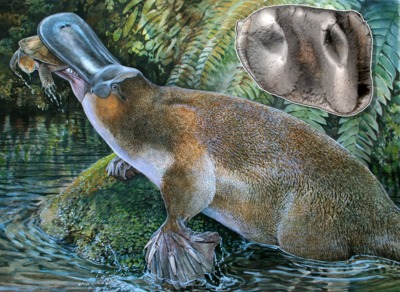Giant extinct platypus discovered
The fossil of a huge, carnivorous platypus about a metre long has been discovered in the Riversleigh World Heritage Area of north-western Queensland.
The new species, named Obdurodon tharalkooschild, has been identified from a highly distinctive tooth found in a deposit that has not been dated yet, but is likely to be between 15 and 5 million years old.

Unlike present day platypuses, this extinct species had well-developed and fully functional teeth. This means it probably fed on crayfish, lungfish, frogs, small turtles and other animals that were preserved with it in the Two Tree Site fossil deposit.
The discovery was made by Rebecca Pian, a PhD candidate at Columbia University and former University of New South Wales (UNSW) Honours student, Professor Mike Archer and Associate Professor Suzanne Hand of the UNSW School of Biological Earth and Environmental Sciences.
“A new platypus species, even one that is highly incomplete, is a very important aid in developing understanding about these fascinating mammals,” said Pian.
Based on the size of its tooth, it is estimated that the extinct species would have been twice the size of the modern platypus.
“Like other platypuses, it was probably a mostly aquatic mammal, and would have lived in and around the freshwater pools in the forests that covered the Riversleigh area millions of years ago,” said Hand.
Before the discovery of the new species, the fossil record suggested that only one species of platypus existed on the planet at any one time, with platypuses becoming smaller and the size of their teeth reducing through time.
The modern platypus lacks teeth as an adult and instead bears horny pads in its mouth; the new extinct species is unlikely to have been its immediate ancestor.
“Discovery of this new species was a shock to us because, prior to this, the fossil record suggested that the evolutionary tree of platypuses was a relatively linear one,” said Archer. “Now we realise that there were unanticipated side branches on this tree, some of which became gigantic.”
Toothed platypuses, Monotrematum sudamericanum, were present in South America until 61 million years ago.
The oldest fossil platypus found in Australia was the small, toothed species, Obdurodon insignis, from 26-million-year-old lake deposits in what is now the Simpson Desert.
A larger species, Obdurodon dicksoni, was found in 19- to 15-million-year-old deposits at Riversleigh, and the remains include the only known fossil platypus skull.
Obdurodon tharalkooschild is the second platypus species unearthed at Riversleigh.
The study has been published in the Journal of Vertebrate Palaeontology.
Damaged RNA, not DNA, revealed as main cause of acute sunburn
Sunburn has traditionally been attributed to UV-induced DNA damage, but it turns out that this is...
Multi-ethnic studies identify new genes for depression
Two international studies have revealed hundreds of previously unknown genetic links to...
Oxygen deprivation may contribute to male infertility
Medical conditions that deprive the testes of oxygen, such as sleep apnoea, may be contributing...



